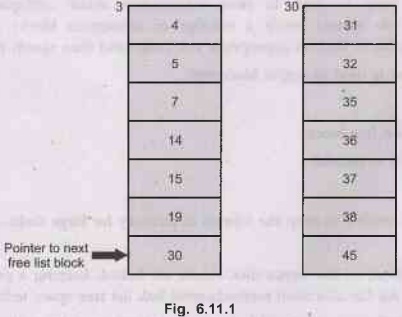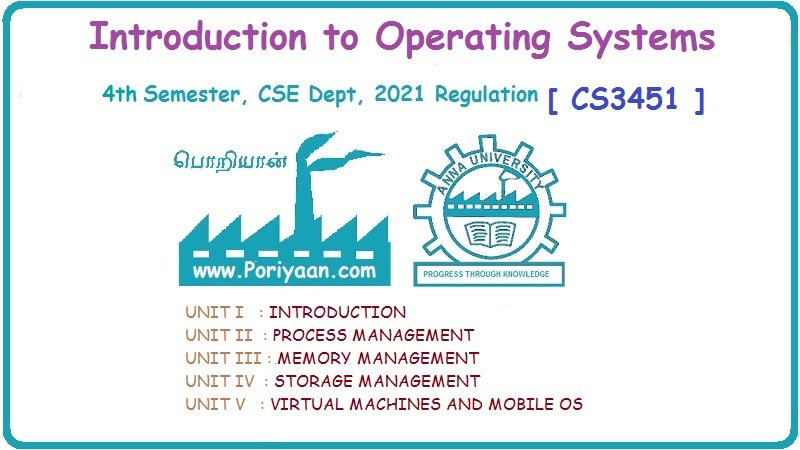Introduction to Operating Systems: Unit IV(b): File System
Free Space Management
File System - Introduction to Operating Systems
Space that is allocated to files must be managed and space which is not allocated to any file must be managed. To keep track of free disk space, the system maintains a free space list.
Free Space Management
•
Space that is allocated to files must be managed and space which is not
allocated to any file must be managed. To keep track of free disk space, the
system maintains a free space list. File allocation table and disk allocation
both are required to manage free space properly.
•
When a file is deleted, its disk space is added to the free-space list.
•
Following are the techniques used for free space management:
1.
Bit tables or bit vector
2.
Chained free portions or linked list
3.
Indexing or grouping
4. Free block list or counting
1.
Bit tables or bit vector old
•
Each block on the disk is represented by bit. It uses vector chain for blocks.
Free block is represented by o and used block represented by 1.
• For example, consider a disk where
blocks 3, 4, 5, 7, 9, 14, 15, 19, 30, 31, 32, 35, 36, 37, 38 are free blocks
and rest of the blocks are allocated. The free space is shown below:
111000101011110011101111111111000110000
•
The memory required for a block bitmap = Disk size / 8 × (block size of file
system)
• Bit map requires extra space. For example:

• When bit table is stored into the
memory, then exhaustive search of the table can ano slow file system
performance. Most of the file system use auxiliary data structure al for bit
table. File system also maintain summary table. Summary table contains
sub-range, number of free blocks and maximum sized contiguous number of free
blocks.
• Summary table is used to store
information about contiguous free blocks. Whenever file system needs a number
of contiguous blocks, it can scan the summary table to find an appropriate
sub-range and then search that sub-range. This method is used in Apple
Macintosh.
Advantage
:
a.
Easy to find a free blocks
b.
It is as small as possible.
Disadvantage
:
It may not be feasible to keep the
bitmap in memory for large disks.
2. Link list
• In this method, all free space disk
blocks are linked, keeping a pointer to the first free block. All file
allocation methods used link list free space techniques.
• There is small space overhead because
there is no need for a disk allocation table. In the above example, free blocks
are 3, 4, 5, 7, 9, 14, 15, 19, 30, 31, 32, 35, 36, 37, 38. Here free block
pointer is on block number 3. Block 3 contains pointer to block 4, block 4
contains pointer to block 5 and block 5 contains pointer to block 7 and so on.
•
This method is not efficient because to reach free block 9, we have to traverse
973 block 3, 4, 5 and 7 then we will reach to block 9.
• Disk will become quite fragmented after some use. Many
portions will be a single block long.
3.
Grouping
• First free block contains the
addresses of n free blocks. The first n-1 of these blocks is actually free. The
last block also contains the address of another n free block.
• Consider the free blocks: 3, 4, 5,
7, 9, 14, 15, 19, 30, 31, 32, 35, 36, 37, 38
•
When
all the blocks in the group have been allocated, then use the block that held
the pointer.
• Because of grouping method, address of
a large number of free blocks can be found quickly.
4.
Counting
• It keeps the address of the first free
block and the number n of free contiguous blocks that follow the first block.
Each entry in the free space list then consists of a disk address and a count.

Introduction to Operating Systems: Unit IV(b): File System : Tag: : File System - Introduction to Operating Systems - Free Space Management
Related Topics
Related Subjects
Introduction to Operating Systems
CS3451 4th Semester CSE Dept | 2021 Regulation | 4th Semester CSE Dept 2021 Regulation
